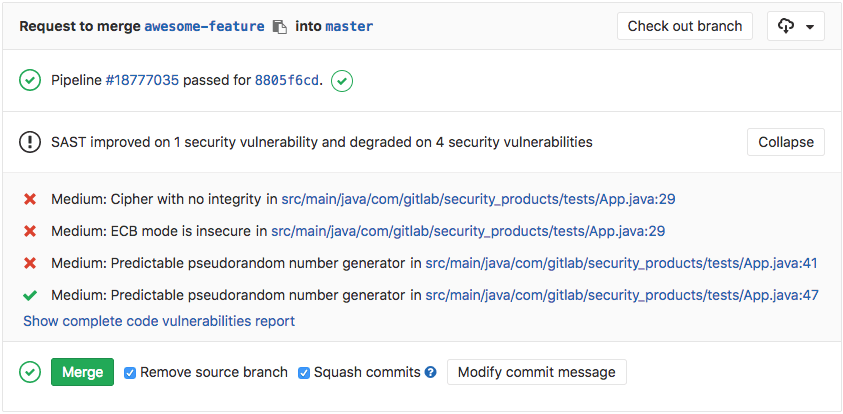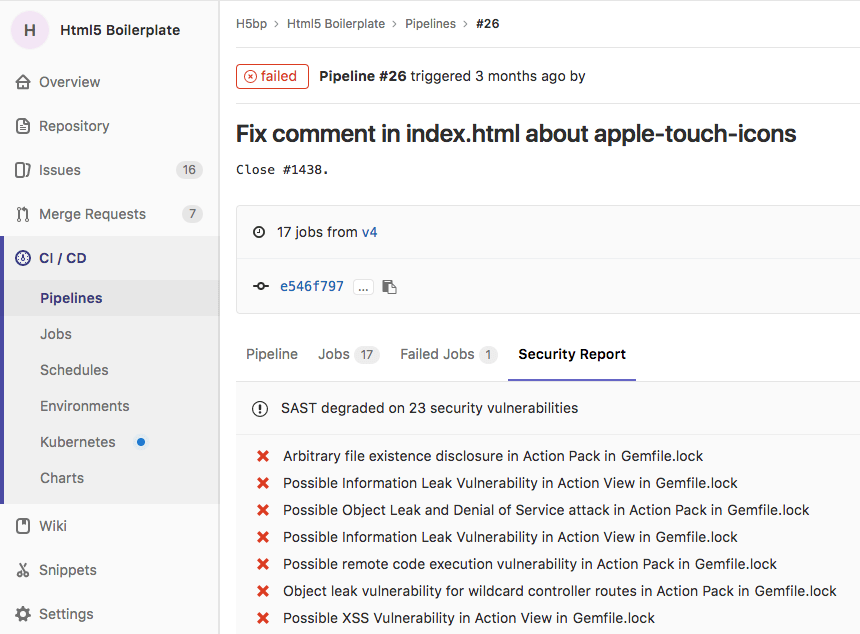12 KiB
Static Application Security Testing (SAST) [ULTIMATE]
Introduced in GitLab Ultimate 10.3.
NOTE: 4 of the top 6 attacks were application based. Download our whitepaper, "A Seismic Shift in Application Security" to learn how to protect your organization.
Overview
If you are using GitLab CI/CD, you can analyze your source code for known vulnerabilities using Static Application Security Testing (SAST).
You can take advantage of SAST by either including the CI job in
your existing .gitlab-ci.yml file or by implicitly using
Auto SAST
that is provided by Auto DevOps.
GitLab checks the SAST report, compares the found vulnerabilities between the source and target branches, and shows the information right on the merge request.
The results are sorted by the priority of the vulnerability:
- Critical
- High
- Medium
- Low
- Unknown
- Everything else
Use cases
- Your code has a potentially dangerous attribute in a class, or unsafe code that can lead to unintended code execution.
- Your application is vulnerable to cross-site scripting (XSS) attacks that can be leveraged to unauthorized access to session data.
Requirements
To run a SAST job, you need GitLab Runner with the
docker or
kubernetes
executor running in privileged mode. If you're using the shared Runners on GitLab.com,
this is enabled by default.
Supported languages and frameworks
The following table shows which languages, package managers and frameworks are supported and which tools are used.
| Language (package managers) / framework | Scan tool | Introduced in GitLab Version |
|---|---|---|
| .NET | Security Code Scan | 11.0 |
| Any | Gitleaks and TruffleHog | 11.9 |
| C/C++ | Flawfinder | 10.7 |
| Elixir (Phoenix) | Sobelow | 11.10 |
| Go | Gosec | 10.7 |
| Groovy (Ant, Gradle, Maven and SBT) | SpotBugs with the find-sec-bugs plugin | 11.3 (Gradle) & 11.9 (Ant, Maven, SBT) |
| Java (Ant, Gradle, Maven and SBT) | SpotBugs with the find-sec-bugs plugin | 10.6 (Maven), 10.8 (Gradle) & 11.9 (Ant, SBT) |
| Javascript | ESLint security plugin | 11.8 |
| Node.js | NodeJsScan | 11.1 |
| PHP | phpcs-security-audit | 10.8 |
| Python (pip) | bandit | 10.3 |
| Ruby on Rails | brakeman | 10.3 |
| Scala (Ant, Gradle, Maven and SBT) | SpotBugs with the find-sec-bugs plugin | 11.0 (SBT) & 11.9 (Ant, Gradle, Maven) |
| Typescript | TSLint config security | 11.9 |
NOTE: Note: The Java analyzers can also be used for variants like the Gradle wrapper, Grails and the Maven wrapper.
Configuring SAST
To enable SAST in your project, define a job in your .gitlab-ci.yml file that generates the
SAST report artifact.
This can be done in two ways:
- For GitLab 11.9 and later, including the provided SAST
.gitlab-ci.ymltemplate (recommended). - Manually specifying the job definition. Not recommended unless using GitLab 11.8 and earlier.
Including the provided template
NOTE: Note: The CI/CD SAST template is supported on GitLab 11.9 and later versions. For earlier versions, use the manual job definition.
A CI/CD SAST template
with the default SAST job definition is provided as a part of your GitLab
installation which you can include
in your .gitlab-ci.yml file.
To enable SAST using the provided template, add the following to your .gitlab-ci.yml
file:
include:
template: SAST.gitlab-ci.yml
The included template will create a sast job in your CI/CD pipeline and scan
your project's source code for possible vulnerabilities.
The report will be saved as a SAST report artifact that you can later download and analyze. Due to implementation limitations, we always take the latest SAST artifact available. Behind the scenes, the GitLab SAST Docker image is used to detect the languages/frameworks and in turn runs the matching scan tools.
Customizing the SAST settings
The SAST settings can be changed through environment variables by using the
variables parameter in .gitlab-ci.yml.
These variables are documented in the
SAST tool documentation.
In the following example, we include the SAST template and at the same time we
set the SAST_GOSEC_LEVEL variable to 2:
include:
template: SAST.gitlab-ci.yml
variables:
SAST_GOSEC_LEVEL: 2
Because the template is evaluated before the pipeline configuration, the last mention of the variable will take precedence.
Overriding the SAST template
If you want to override the job definition (for example, change properties like
variables or dependencies), you need to declare a sast job after the
template inclusion and specify any additional keys under it. For example:
include:
template: SAST.gitlab-ci.yml
sast:
variables:
CI_DEBUG_TRACE: "true"
Manual job definition for GitLab 11.5 and later
For GitLab 11.5 and GitLab Runner 11.5 and later, the following sast
job can be added:
sast:
stage: test
image: docker:stable
variables:
DOCKER_DRIVER: overlay2
allow_failure: true
services:
- docker:stable-dind
script:
- export SAST_VERSION=${SP_VERSION:-$(echo "$CI_SERVER_VERSION" | sed 's/^\([0-9]*\)\.\([0-9]*\).*/\1-\2-stable/')}
- |
docker run \
--env SAST_ANALYZER_IMAGES \
--env SAST_ANALYZER_IMAGE_PREFIX \
--env SAST_ANALYZER_IMAGE_TAG \
--env SAST_DEFAULT_ANALYZERS \
--env SAST_EXCLUDED_PATHS \
--env SAST_BANDIT_EXCLUDED_PATHS \
--env SAST_BRAKEMAN_LEVEL \
--env SAST_GOSEC_LEVEL \
--env SAST_FLAWFINDER_LEVEL \
--env SAST_DOCKER_CLIENT_NEGOTIATION_TIMEOUT \
--env SAST_PULL_ANALYZER_IMAGE_TIMEOUT \
--env SAST_RUN_ANALYZER_TIMEOUT \
--volume "$PWD:/code" \
--volume /var/run/docker.sock:/var/run/docker.sock \
"registry.gitlab.com/gitlab-org/security-products/sast:$SAST_VERSION" /app/bin/run /code
dependencies: []
artifacts:
reports:
sast: gl-sast-report.json
You can supply many other settings variables
via docker run --env to customize your job execution.
Manual job definition for GitLab 11.4 and earlier (deprecated)
CAUTION: Deprecated:
Before GitLab 11.5, the SAST job and artifact had to be named specifically
to automatically extract report data and show it in the merge request widget.
While these old job definitions are still maintained, they have been deprecated
and may be removed in the next major release, GitLab 12.0. You are strongly
advised to update your current .gitlab-ci.yml configuration to reflect that change.
For GitLab 11.4 and earlier, the SAST job should look like:
sast:
image: docker:stable
variables:
DOCKER_DRIVER: overlay2
allow_failure: true
services:
- docker:stable-dind
script:
- export SAST_VERSION=${SP_VERSION:-$(echo "$CI_SERVER_VERSION" | sed 's/^\([0-9]*\)\.\([0-9]*\).*/\1-\2-stable/')}
- docker run
--env SAST_CONFIDENCE_LEVEL="${SAST_CONFIDENCE_LEVEL:-3}"
--volume "$PWD:/code"
--volume /var/run/docker.sock:/var/run/docker.sock
"registry.gitlab.com/gitlab-org/security-products/sast:$SAST_VERSION" /app/bin/run /code
artifacts:
paths: [gl-sast-report.json]
Secret detection
GitLab is also able to detect secrets and credentials that have been unintentionally pushed to the repository. For example, an API key that allows write access to third-party deployment environments.
This check is performed by a specific analyzer during the sast job. It runs regardless of the programming
language of your app, and you don't need to change anything to your
CI/CD configuration file to turn it on. Results are available in the SAST report.
GitLab currently includes Gitleaks and TruffleHog checks.
Security report under pipelines
Introduced in GitLab Ultimate 10.6.
Visit any pipeline page which has a sast job and you will be able to see
the security report tab with the listed vulnerabilities (if any).
Security Dashboard
The Security Dashboard is a good place to get an overview of all the security vulnerabilities in your groups and projects. Read more about the Security Dashboard.
Interacting with the vulnerabilities
Once a vulnerability is found, you can interact with it. Read more on how to interact with the vulnerabilities.

